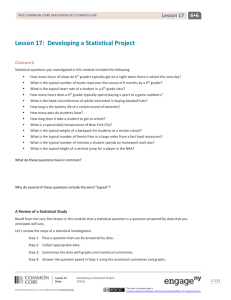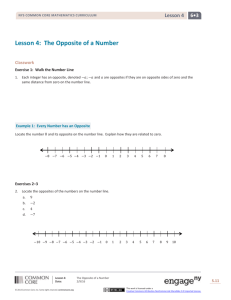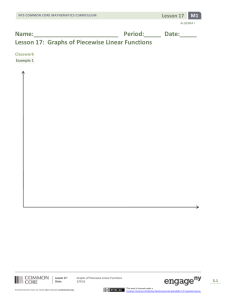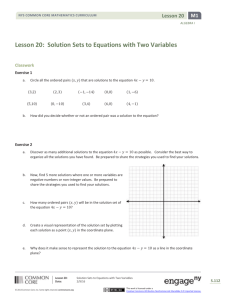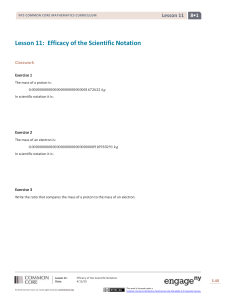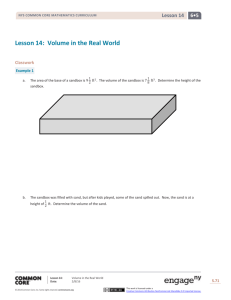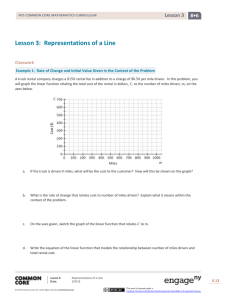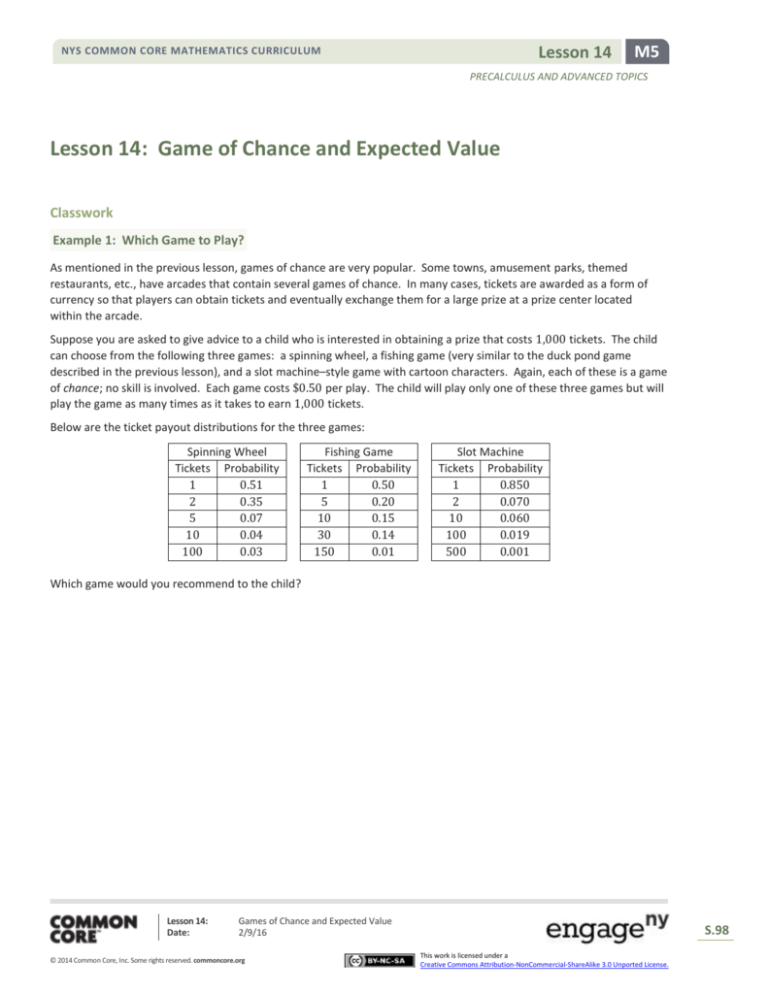
Lesson 14
NYS COMMON CORE MATHEMATICS CURRICULUM
M5
PRECALCULUS AND ADVANCED TOPICS
Lesson 14: Game of Chance and Expected Value
Classwork
Example 1: Which Game to Play?
As mentioned in the previous lesson, games of chance are very popular. Some towns, amusement parks, themed
restaurants, etc., have arcades that contain several games of chance. In many cases, tickets are awarded as a form of
currency so that players can obtain tickets and eventually exchange them for a large prize at a prize center located
within the arcade.
Suppose you are asked to give advice to a child who is interested in obtaining a prize that costs 1,000 tickets. The child
can choose from the following three games: a spinning wheel, a fishing game (very similar to the duck pond game
described in the previous lesson), and a slot machine–style game with cartoon characters. Again, each of these is a game
of chance; no skill is involved. Each game costs $0.50 per play. The child will play only one of these three games but will
play the game as many times as it takes to earn 1,000 tickets.
Below are the ticket payout distributions for the three games:
Spinning Wheel
Tickets Probability
1
0.51
2
0.35
5
0.07
10
0.04
100
0.03
Fishing Game
Tickets Probability
1
0.50
5
0.20
10
0.15
30
0.14
150
0.01
Slot Machine
Tickets Probability
1
0.850
2
0.070
10
0.060
100
0.019
500
0.001
Which game would you recommend to the child?
Lesson 14:
Date:
Games of Chance and Expected Value
2/9/16
© 2014 Common Core, Inc. Some rights reserved. commoncore.org
S.98
This work is licensed under a
Creative Commons Attribution-NonCommercial-ShareAlike 3.0 Unported License.
NYS COMMON CORE MATHEMATICS CURRICULUM
Lesson 14
M5
PRECALCULUS AND ADVANCED TOPICS
Exercises 1–3
1.
At first, glance of the probability distributions of the three games, without performing any calculations, which do
you think might be the best choice and why?
2.
Perform necessary calculations to determine which game to recommend to the child. Explain your choice in terms
of both tickets and price. Is this the result you anticipated?
Spinning Wheel
Tickets Probability
1
0.51
2
0.35
5
0.07
10
0.04
100
0.03
3.
Fishing Game
Tickets Probability
1
0.50
5
0.20
10
0.15
30
0.14
150
0.01
Slot Machine
Tickets Probability
1
0.850
2
0.070
10
0.060
100
0.019
500
0.001
The child states that she would like to play the slot machine game because it offers a chance of winning 500 tickets
per game, and that means she might only have to play twice to reach her goal, and none of the other games offer
that possibility. Using both the information from the distributions above and your expected value calculations,
explain to her why this might not be the best strategy.
Lesson 14:
Date:
Games of Chance and Expected Value
2/9/16
© 2014 Common Core, Inc. Some rights reserved. commoncore.org
S.99
This work is licensed under a
Creative Commons Attribution-NonCommercial-ShareAlike 3.0 Unported License.
NYS COMMON CORE MATHEMATICS CURRICULUM
Lesson 14
M5
PRECALCULUS AND ADVANCED TOPICS
Example 2: Insurance
Insurance companies consider expected value when developing insurance products and determining the pricing
structure of these products. From the perspective of the insurance company, the company “gains” each time it earns
more money from a customer than it needs to pay out to the customer.
An example of this would be a customer paying a one-time premium (that’s the cost of insurance) of $500.00 to
purchase a one-year, $10,000.00 casualty policy on an expensive household item that ends up never being damaged,
stolen, etc., in that one-year period. In that case, the insurance company gained $500.00 from that transaction.
However, if something catastrophic did happen to the household item during that one-year period (such that it was
stolen, or damaged so badly that it could not be repaired, etc.), the customer could then ask the insurance company for
the $10,000.00 of insurance money per the agreement, and the insurance company would lose $9,500.00 from the
transaction.
Imagine that an insurance company is considering offering two coverage plans for two major household items that
owners would typically want to insure (or are required to insure by law). Based on market analysis, the company
believes that it could sell the policies as follows:
Plan A: Customer pays a one-year premium of $600.00 and gets $10,000.00 of insurance money if Item A is
ever stolen, or damaged so badly that it could not be repaired, etc., that year.
Plan B: Customer pays a one-year premium of $900.00 and gets $8,000.00 of insurance money if Item B is ever
stolen, or damaged so badly that it could not be repaired, etc., that year.
It is estimated that the chance of the company needing to pay out on a Plan A policy is 0.09%, and the chance of the
company needing to pay out on a Plan B policy is 3.71%.
Which plan should the company offer?
Lesson 14:
Date:
Games of Chance and Expected Value
2/9/16
© 2014 Common Core, Inc. Some rights reserved. commoncore.org
S.100
This work is licensed under a
Creative Commons Attribution-NonCommercial-ShareAlike 3.0 Unported License.
NYS COMMON CORE MATHEMATICS CURRICULUM
Lesson 14
M5
PRECALCULUS AND ADVANCED TOPICS
Exercise 4
4.
The company can market and maintain only one of the two policy types, and some people in the company feel it
should market Plan B since it earns the higher premium from the customer and has the lower claim payout amount.
Assuming that the cost of required resources for the two types of policies is the same (for the advertising, selling,
maintaining, etc., of the policies) and that the same number of policies would be sold for either Plan A or Plan B. In
terms of earning the most money for the insurance company, do you agree with the Plan B decision? Explain your
decision.
Lesson 14:
Date:
Games of Chance and Expected Value
2/9/16
© 2014 Common Core, Inc. Some rights reserved. commoncore.org
S.101
This work is licensed under a
Creative Commons Attribution-NonCommercial-ShareAlike 3.0 Unported License.
Lesson 14
NYS COMMON CORE MATHEMATICS CURRICULUM
M5
PRECALCULUS AND ADVANCED TOPICS
Lesson Summary
The application of expected value is very important to many businesses, lotteries, and others. It helps to determine
the average gain or loss that can be expected for a given iteration of a probability trial.
By comparing the expected value, 𝐸(𝑋), for different games of chance (or situations that closely mirror games of
chance), one can determine the most effective strategy to reach one’s goal.
Problem Set
1.
In the previous lesson, a duck pond game was described with the following payout distribution to its players:
Event
Small
Medium
Large
𝑌
−$1.50
−$0.50
$3.00
Probability of 𝑌
0.60
0.30
0.10
where 𝑌 = the net amount that a player won (or lost) playing the duck game 1 time.
This led to a situation where the people running the game could expect to gain $0.75 on average per attempt.
Someone is considering changing the probability distribution as follows:
Event
Small
Medium
Large
𝑌
−$1.50
−$0.50
$3.00
Probability of 𝑌
0.70
0.18
0.12
Will this adjustment favor the players, favor the game’s organizers, or will it make no difference at all in terms of the
amount the organization can expect to gain on average per attempt?
2.
In the previous lesson’s Problem Set, you were asked to make a model of a spinning wheel with a point distribution
as follows:
You gain 2 points 50% of the time.
You lose 3 points 25% of the time.
You neither gain nor lose any points 25% of the time.
When 𝑋 = the number of points earned in a given spin, 𝐸(𝑋) = 0.25 points.
Suppose you change the probabilities by “moving” 10% of the distribution as follows:
You gain 2 points 60% of the time.
You lose 3 points 15% of the time.
You neither gain nor lose any points 25% of the time.
Lesson 14:
Date:
Games of Chance and Expected Value
2/9/16
© 2014 Common Core, Inc. Some rights reserved. commoncore.org
S.102
This work is licensed under a
Creative Commons Attribution-NonCommercial-ShareAlike 3.0 Unported License.
Lesson 14
NYS COMMON CORE MATHEMATICS CURRICULUM
M5
PRECALCULUS AND ADVANCED TOPICS
3.
4.
5.
a.
Without performing any calculations, make a guess as to whether or not this new distribution will lead to a
player needing a fewer number of attempts than before on average to attain 5 or more points. Explain your
reasoning.
b.
Determine the expected value of points earned from 1 game based on this new distribution. Based on your
computation, how many spins on average do you think it might take to reach 5 points?
c.
Does this value from part (b) support your guess in part (a)? (Remember that with the original distribution and
its expected value of 0.25 points per play, it would have taken 20 spins on average to reach 5 points.)
You decide to invest $1,000.00 in the stock market. After researching, you estimate the following probabilities:
Stock A has a 73% chance of earning a 20% profit in 1 year, an 11% chance of earning no profit, and a 16%
chance of being worthless.
Stock B has a 54% chance of earning a 75% profit in 1 year, a 23% chance of earning no profit, and a 23%
chance of being worthless.
a.
At first glance, which seems to be the most appealing?
b.
Which stock should you decide to invest in and why? Is this what you predicted?
The clock is winding down in quarter 4 of the basketball game. The scores are close. It is still anyone’s game. As the
team’s coach, you need to quickly decide which player to put on the court to help ensure your team’s success.
Luckily, you have the historical data for Player A and Player B in front of you.
80% of Player A’s shot attempts have been 2-point field goals, and 60% of them have hit their marks. The
remaining shots have been 3-point field goals, and 20% of them have hit their marks.
85% of Player B’s shot attempts have been 2-point field goals, and 62% of them have hit their marks. The
remaining shots have been 3-point field goals, and 22% of them have hit their marks.
a.
At first glance, whom would you put in and why?
b.
Based on these statistics, which player might be more likely to help lead your team to victory and why?
Prior versions of College Board examinations (SAT, AP) awarded the test taker with 1 point for each correct answer
1
and deducted point for each incorrect answer. Current versions have eliminated the point deduction for incorrect
4
responses (test takers are awarded 0 points).
The math section of the SAT contains 44 multiple-choice questions, with choices A–E. Suppose you answer all the
questions but end up guessing on eight questions. How might your math score look different on your score report
using each point system? Explain your answer.
Lesson 14:
Date:
Games of Chance and Expected Value
2/9/16
© 2014 Common Core, Inc. Some rights reserved. commoncore.org
S.103
This work is licensed under a
Creative Commons Attribution-NonCommercial-ShareAlike 3.0 Unported License.

